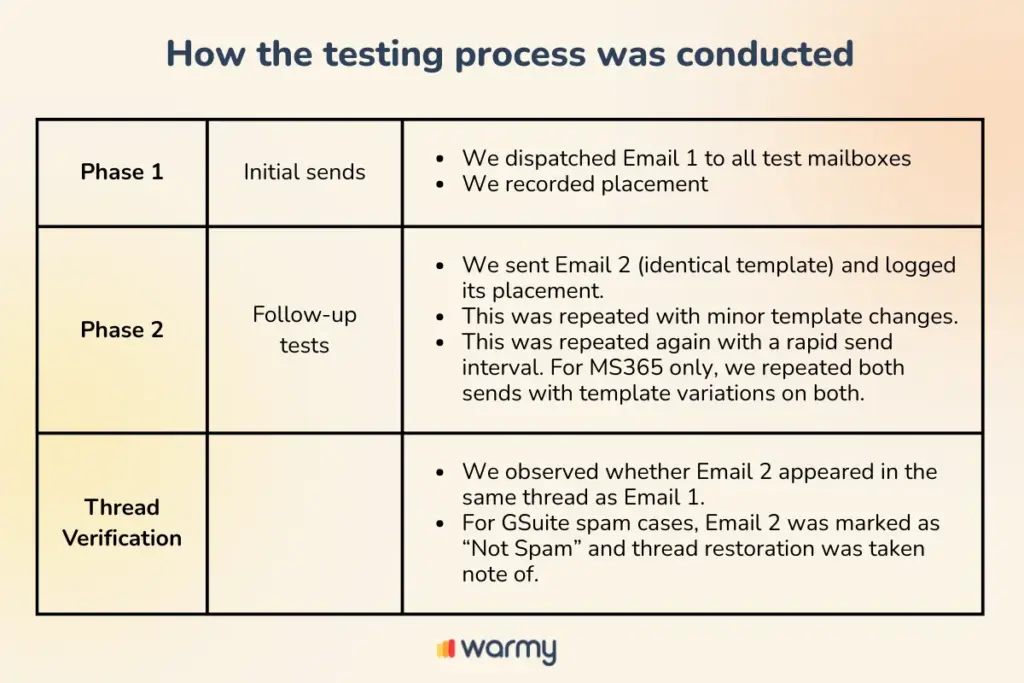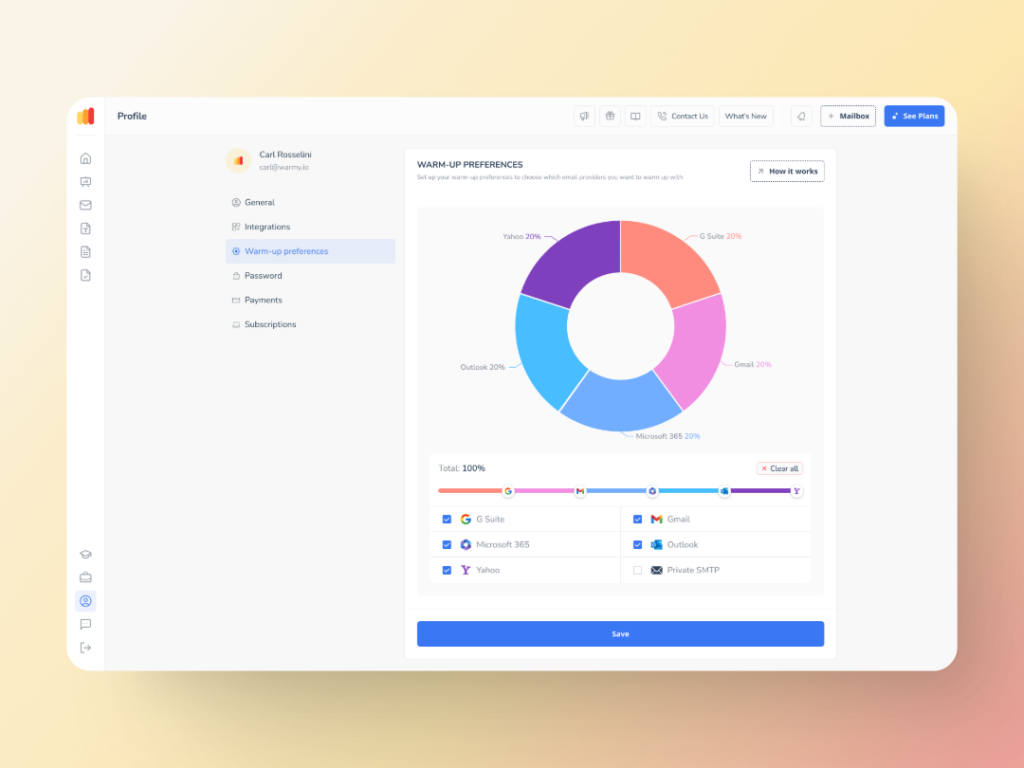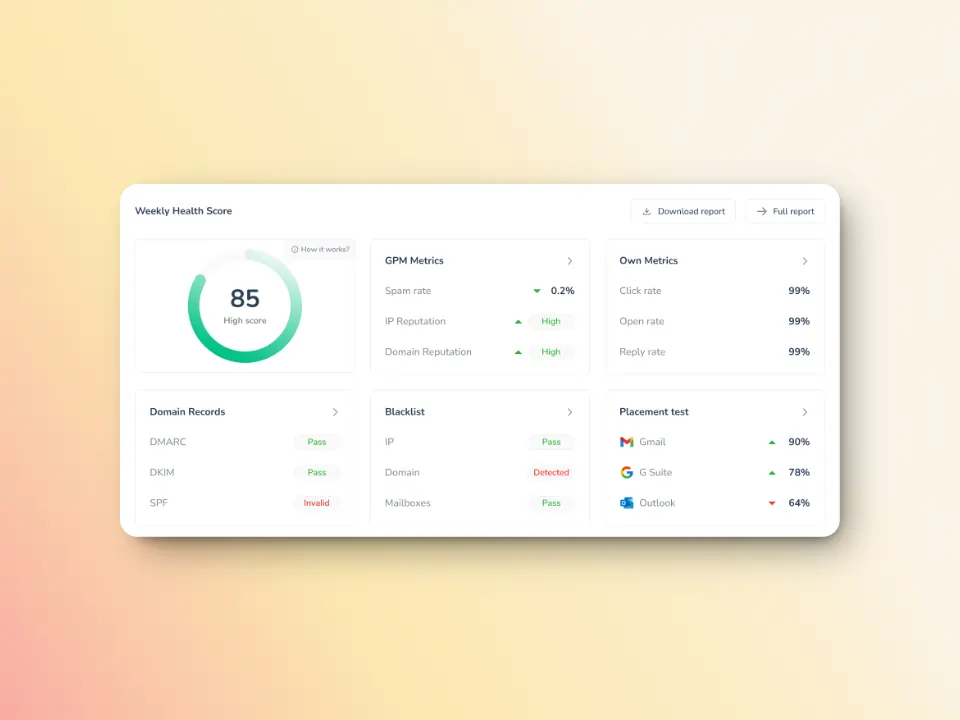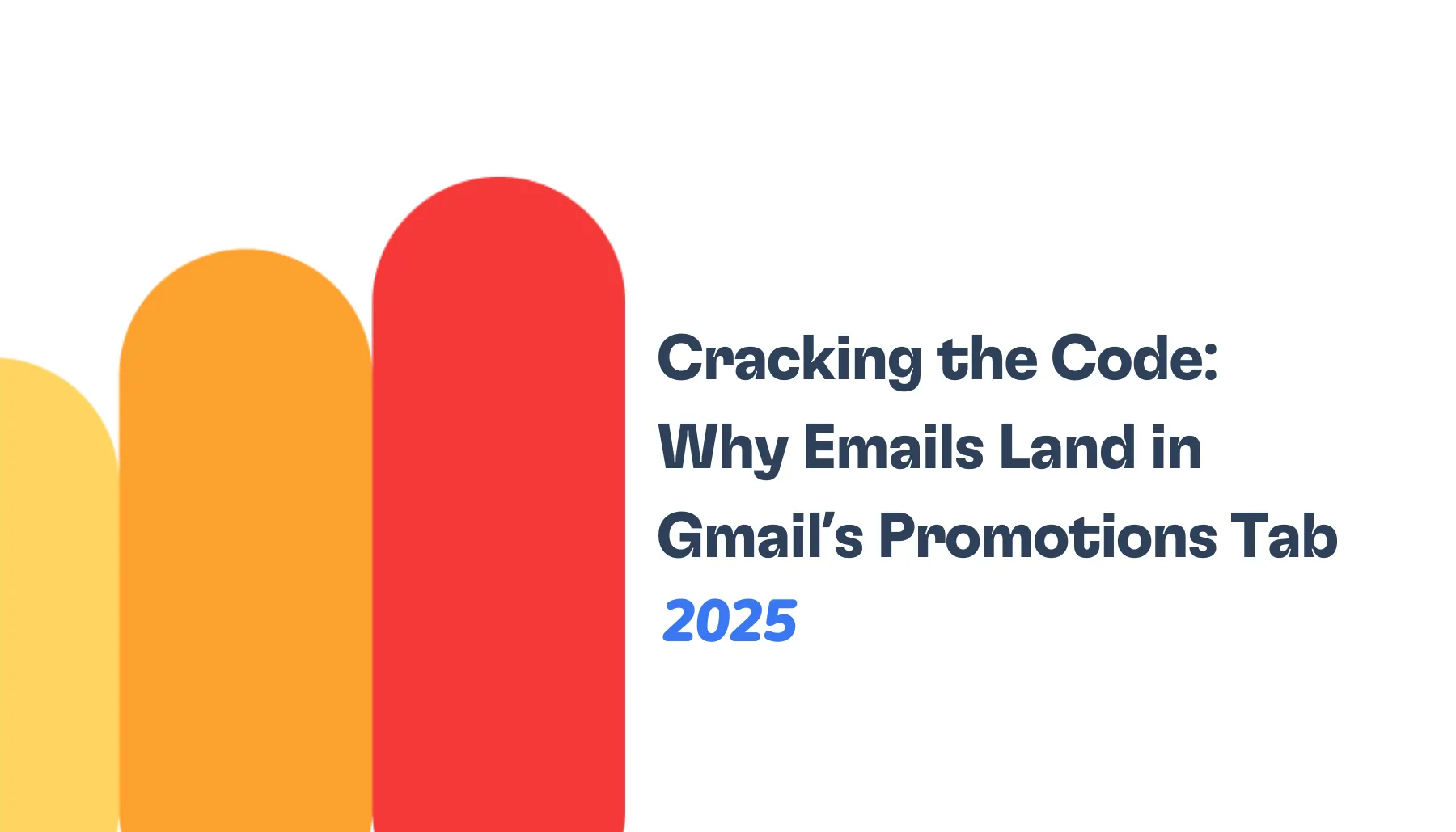In the world of email deliverability, most senders obsess over one moment: the first send. Will it land in the inbox or spiral into spam? But what if that moment matters far more than we ever realized?
At Warmy.io, we set out to explore a critical but overlooked question: Does the inbox placement of your first email (regardless of content, timing, or format) determine the fate of all follow-ups in the same thread? And more importantly, does this behavior differ between major platforms like GSuite and MS365?
The findings surprised even our seasoned deliverability experts. This blog breaks down our latest research, testing conditions, platform-specific quirks, and—most importantly—what it means for your campaigns moving forward.
Whether you’re running cold outreach, lead nurturing, or customer onboarding sequences, this report will help you understand why the first message in your thread isn’t just the first impression—it’s the whole game.
Behind the scenes: how we engineered the inbox experiment
“Can a successful first email guarantee smooth inbox placement for all follow-ups?”
“Does the initial inbox placement lock in thread behavior—or can follow-ups shift the outcome?”
These were the main questions Warmy’s Research Team sought to answer. To understand how email threads behave after the first message lands, we needed more than assumptions—we needed structured, platform-specific experimentation.
Q: What are email threads?
A: Email threads are a series of connected messages exchanged between participants, where each subsequent email is grouped under the original message, maintaining continuity in the conversation. They help keep related responses organized in a single view, making it easier to follow discussions.
Our research team at Warmy.io designed a multi-phase test to isolate the key variables that influence follow-up deliverability and threading in both GSuite and MS365 environments.
Our setup at a glance
We used the following configuration to create real-world conditions while ensuring repeatable, measurable results:
- Sender configuration: All emails were sent using an OpenSRS-hosted SMTP environment—neutral and industry-standard.
- Recipients: We tested across 5 unique GSuite inboxes and 5 unique MS365 inboxes to ensure diversity and reduce platform-level bias.
- Measurement tools:
- Manual inbox and spam folder checks
- Gmail API actions (e.g., “Mark as Not Spam”)
- Warmy’s proprietary Inbox Placement Checker
The testing process: one thread, many scenarios
To dissect the platform behaviors, we ran multiple test variations, all based on two core email messages: Email 1 (initial message) and Email 2 (follow-up message).
We tested these under different conditions:
- Identical follow-up: Email 2 is the same as Email 1.
- Minor template change: Small wording tweaks in Email 2 (e.g., sentence rephrasing or a new line).
- Short time gap: Email 2 sent shortly after Email 1
- Template variation recovery (MS365 only): Adjusted both Email 1 and Email 2 templates to test recovery from initial spam placement.
Here is an overview of how the testing process was conducted:

Key findings: a snapshot of what we discovered
After running our in-depth tests, we observed some clear and striking patterns in how GSuite and MS365 handle follow-up emails.
GSuite is the harsh gatekeeper

The table above shows the different results per condition—inbox placement of the two individual emails as well as the impact on threading.
In a nutshell, it was observed that if Email 1 lands in the inbox and Email 2 falls into the spam folder, the threads in Gsuite are broken. However, marking an email as “Not Spam” can restore the thread but not 100% of the time.
We found that GSuite requires a delicate balance since it’s more sensitive. Small tweaks in the template or even trying out shorter sending intervals can flip an email from landing in the inbox to landing in spam (and vice versa).
Key finding: Inbox today, spam tomorrow—even if nothing changes.
Key action item: Even after achieving an initial inbox placement, senders must carefully manage and monitor the content and timing of follow-ups to ensure thread continuity.
MS365 is the loyal guardian

When it comes to MS365, we found that the inbox status of Email 1 drives all follow-ups. If Email 1 lands in the inbox, Email 2 will follow suit. If Email 1 lands in spam, so will Email 2. Called “first message dominance,” this speaks to how MS365’s deliverability relies heavily on the success of the first message.
Additionally, MS265 is more lenient with second chances. Recovery is very much possible. Even if Email 1 lands in spam, making small adjustments like tweaking content and sending cadence can restore thread continuity.
Key finding: The first email sets the tone—and the path—for all future messages.
Key action item: Get it in the inbox, and the follow-ups will follow suit.
Additional reports on MS365 Deliverability:
Tactical takeaways for your email campaigns
Based on the findings from our research, it’s clear that the path to successful email threading and deliverability varies significantly between GSuite and MS365.
Here are some practical actionables you can implement to optimize your email outreach and improve thread continuity, along with the corresponding Warmy.io features to help you execute these strategies effectively.
Master the first send: GSuite and MS365 both rely on it
The first email in your sequence is critical. So how can you ensure that it lands in the inbox? Deliverability is a critical factor here and there are many contributors. Ultimately, sender reputation plays a huge role.
Q: What is the sender reputation’s role in ensuring the first email lands in the inbox?
A: Sender reputation plays a critical role in determining whether the first email lands in the inbox, as email providers assess the sender’s history of delivering legitimate, non-spammy messages. A strong reputation increases the likelihood of inbox placement, while a poor reputation can lead to messages being flagged as spam.
🔖 Related Reading: The Science and Process of Warming Up Newly Created Email Domains is another report from the Warmy Research Team that tackles how warmup strategies affect email deliverability from new domains.
Warmy’s AI-powered email warmup enables senders to experience 95% inbox placement by doing the following:
- Gradually increasing the sending volume over time
- Simulating human-like interactions such as opens, replies, and removing emails from the spam folder
- Providing insights and analytics throughout the warmup process to help senders identify and tackle issues
Using WarmUp Preferences feature tailors the process even more by allowing senders to tailor the warmup distribution across GSuite, Gmail, MS365, Outlook, Yahoo, and even Private SMTP. Even engagement patterns can be tailored by choosing between B2B and B2C behavior.

Meanwhile, Warmy’s free deliverability test helps you test your initial deliverability before conducting campaigns to your entire list. This test helps identify the likelihood of your emails to land in the inbox—ensuring that the first send is as successful as possible.
For MS365: Ride the wave of inbox placement
Once your first email lands in the inbox, the following messages will likely inherit that placement. Use this to your advantage and send follow-ups with confidence, knowing they’ll continue in the same thread.
Use Warmy’s Domain Health Hub to periodically monitor if everything is running smoothly. The Domain Health Hub includes:
- A domain health score which draws data from authentication, blacklist presence, and inbox placement tests
- Comprehensive DNS status checks for smoother validation of SPF, DKIM, DMARC records
- Multi-domain monitoring for easier management of domains from one dashboard only

For GSuite: Maintain thread continuity with precision
After a successful first send, carefully monitor your follow-up emails since GSuite can be very sensitive. Small changes in content or fast send intervals can trigger spam filters.
Q: What are spam filters?
A: Spam filters are algorithms used by email providers to identify and block unwanted or potentially harmful emails, preventing them from reaching users’ inboxes.
🔖 Related Reading: Spam filters: everything you need to know
Keep an eye on your content with Warmy’s Template Checker before sending to your list. It allows you to personalize and tweak your content so they are more likely to stay out of the spam folders. This feature is now also available as a Google Chrome extension.

Leverage Warmy’s advanced seed lists for spam recovery
If your first email lands in spam, you still have a chance to recover the thread. While the experiment showed that marking an email as “Not Spam” can help reunite emails, Warmy’s warmup process and advanced seed lists also help behind the scenes.
Warmy’s advanced seed lists are composed of genuine email addresses that simulate real human behavior. Yes, emails are opened, read, scrolled through, and clicked which all help in reducing the chances of landing in spam. But if emails go to spam, they are manually removed and marked as important to improve future deliverability.

Deliverability isn’t just about one email—it’s also about the email threads
Understanding the unique requirements of GSuite and MS365 can significantly improve your email campaigns. For MS365, focus on securing that first successful inbox placement, while for GSuite, you’ll need to manage follow-up timing, content, and pacing to keep the thread intact.
By using Warmy.io’s suite of features, you can ensure your campaigns stay on track, whether you’re working with GSuite, MS365, or both.
In the deliverability journey, your first send determines if your thread will live… or get spammed to death. With the right tools, you don’t have to guess—you can know.
Check out the rest of the report for more comprehensive insights.











